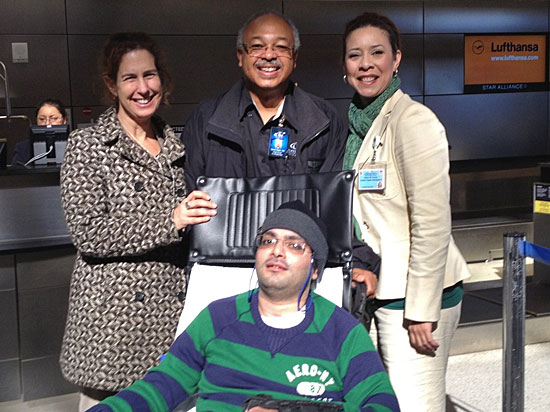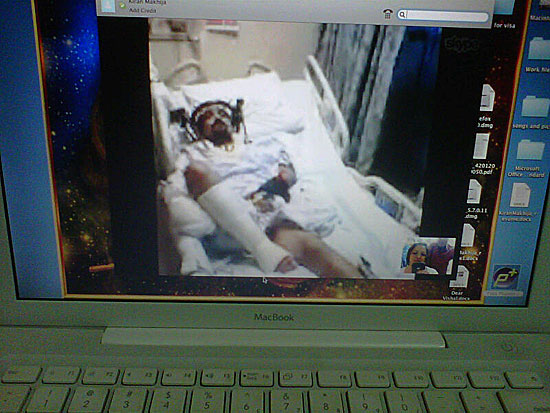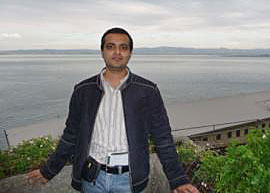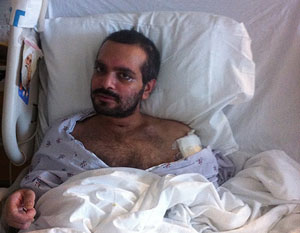A passage to India
January 16, 2013

Vishal Makhija at LAX. With him are, from left, LAC+USC Social Work Supervisor Jan Crary, flight nurse David Hogan and Assistant Hospital Administrator for Medical Services Sandy Correa.
Vishal Makhija is going home.
He journeyed to Los Angeles in 2009 with dreams of becoming an accountant. Instead, he spent the past nine months at Los Angeles County+USC Medical Center—his body broken, his brain permanently damaged from a hit-and-run driver who mowed him down during an evening walk. On Wednesday morning, Makhija’s stay came to an end as he was gently lifted into a special medical transport jet bound for Mumbai, India, where his family will give him the constant care he now needs.
The $19,200 trip is being underwritten by Los Angeles County.
“Our family is middle class by Indian standards but, for us, the cost was out of the question,” says Kiran Makhija, who has lined up a nurse, a physical therapist and a specialized hospital bed in India for her 32-year-old brother. “This is a huge relief, and we are very grateful. I am 100 percent sure that Vishal will heal better and faster with family and friends who love him here.”
Makhija’s case represents an innovative effort by top county health officials to reduce hospital costs while improving patient outcomes for large numbers of hard-to-place indigent patients who are taking up public hospital beds longer than medically necessary.
Dr. Mitchell Katz, director of the county’s Department of Health Services, says he hopes to create a special fund in his budget for “creative discharges” like Makhija’s that, with some imagination, could be solved in ways that do right both by the individual patient and by the county’s limited pool of health care resources.
“Of course, each case is different,” Katz says. “There isn’t a cookie-cutter solution.” Housing and special placements have their own price tags, he notes, and sometimes the circumstances and the medical needs will make the hospital the most cost-effective decision.
“You have to look at each person and figure out what they need,” he says. “But once you’ve figured that out, if there’s a solution that’s substantially less expensive, you should be able to move on it.”
Dr. Christina Ghaly, LAC+USC’s interim chief executive, says that on any given day, approximately 10% of the hospital’s acute care medical beds, and about half of its acute care psychiatric beds, have been occupied for weeks or months by patients who should be in a lower level of care but have no provider willing to take them.
Because LAC+USC is a hospital of last resort for the impoverished, homeless and poorly insured, its rate of hard-to-place patients is far higher than that of private medical centers. At any given time, there are as many as 60 patients like Makhija, who not only increase the public hospital’s costs but also crowd out patients in need of acute beds. Some have remained hospitalized for so long that they’ve lost their housing. The county’s other three public hospitals fare little better, says Ghaly: “There’s a patient at Olive View whom we’ve been trying to place now for two years.”
Katz says he has been concerned about Los Angeles County’s high numbers of hard-to-place patients since he arrived here from San Francisco two years ago. Aside from the financial issues, he says, overlong hospitalizations can have serious medical and psychological downsides for patients, including risk of infection, atrophy and disorientation.
“When I would ask about why we weren’t sending someone to supportive housing or a board and care, or why we weren’t sending people home to be reunified with family, I was told, ‘Well, the county is in the midst of a fiscal crisis and we don’t have the budget.’ But that has never made any sense to me, because, of course, the most expensive thing to do is to keep people in the hospital.”
So the county has begun exploring alternatives, from “respite” beds where homeless convalescents can recuperate in their own bedrooms like more fortunate patients to providing financial incentives to skilled nursing facilities for taking difficult or poorly insured patients. Katz estimates that broadening the options for lower levels of care could save the county “tens of millions of dollars” while improving patient care.
The push is especially important in the wake of the federal Affordable Care Act, which promises to change the business model for health care providers by, among other things, accelerating the trend toward lump sum allotments for patients and procedures, rather than reimbursement for days in a hospital bed or fees for a medical service.
“But it’s not just about money. It’s about finding the right place for the person,” Katz says.
Finding a place for Makhija was especially frustrating because, unlike many indigent patients, his relatives were ready and willing to care for him, says interim CEO Ghaly. “The problem,” she says, “was mainly logistical.”
In fact, Makhija was planning to return to India, according to his sister. “Nothing was going right for him there,” says Kiran Makhija, an account manager for a public relations firm in Dubai.
“He used to dream, talk, visualize, live and breathe U.S.A.,” she says. “He was the biggest fan of Oprah Winfrey and would lay awake late at night watching U.S. destinations on the Travel channel.” But after spending four years in New Jersey on a visa to work and study accounting, she says, he was laid off during the 2008 financial crash and never recovered.
He moved to Los Angeles, hoping to find work, but couldn’t muster more than low-paying jobs in retail, according to Sahib Dudani, a family friend in Laguna Hills to whom Makhija had reached out. Dudani says the young man was living in a rented room in the Boyle Heights apartment, a few blocks from the site of the April 18, 2012, accident.
Hospital records show that paramedics rushed Makhija to the emergency room at 4:25 a.m. after a passerby saw him lying unconscious in an intersection near Soto Street and the I-10 Freeway. His legs were broken, his brain was traumatically injured and his body was marked with tire tracks, but no witnesses came forward and no arrests were made.
“He was coming to me [on the week of the accident] so I could advise him on his next step, including possibly going back to India,” says Dudani, a computer scientist who had known Vishal’s aunt in Mumbai. “When we didn’t hear from him for a couple of days, we got very concerned and went to his address.”
Kiran Makhija says family members were frantic when they learned what had happened, but their applications for emergency visas repeatedly denied. “They said he was in the U.S. illegally, so no one in the family could come for him. But he had a valid green card.”
When her brother emerged from intensive care after a month, the family began brainstorming ways to get him back to India. Kiran, who had been working in Mumbai, took a higher-paying job in the United Arab Emirates, realizing her semi-retired parents would need the extra money.
But as months passed, it became clear that Vishal would never be able to get on a commercial airplane. Although he begged to come home, his injuries had left him impulsive and unable to sit up for more than three hours at one time. He was incontinent and could not move without a specialized stretcher and wheelchair. An international air ambulance would cost tens of thousands, if not hundreds of thousands, of dollars—an impossible sum either way for the family.
Meanwhile, hospital social workers also were running out of options. Makhija had Medi-Cal coverage, but it would only reimburse for hospitalization that was a medical necessity.
By now it was November and the hospital’s unreimbursed costs were approaching $300,000. Every day, social workers were calling ten or more nursing facilities throughout the state, but none would take him. Such facilities, which typically care for elderly patients, resist taking younger, more labor-intensive clients, particularly those with permanent brain injuries and public insurance, such as Medi-Cal, that reimburses far less than private policies, Ghaly says.
“Finally, we exhausted all other efforts and started thinking outside the box,” says Cecil Clark, an associate hospital administrator at LAC+USC.
Clark says that as he cast about for ideas from his team, Sandy Correa, who had come on board the month before as an assistant hospital administrator for medical services, piped up with a question: If Makhija wanted to go home, and his family couldn’t come and retrieve him, why couldn’t the hospital take him to them?
The specialized transport she eventually found, Florida-based Commercial Medical Escorts, Inc., was substantially cheaper than an air ambulance—and less than half the monthly cost of Makhija’s bed at LAC+USC. He’ll be able to lie flat as much as necessary during his journey and will be accompanied by a nurse from Los Angeles to Mumbai, where he is scheduled to land early Friday.
Although such escorts are often used by other hospitals, health services director Katz says they are a departure for Los Angeles County. He says it took more than a month to get all the necessary approvals inside the bureaucracy but the alternative was for the county to foot the bill for Makhija to spend the rest of his life in an institution.
“It is not right to spend all that time in a hospital doing nothing,” says Kiran Makhija. She and her parents are now counting the days until Vishal’s challenging homecoming. “We are not the kind of family that would leave my brother alone.”
Lying in his hospital bed on a recent afternoon under the watchful eye of a nursing attendant, Makhija says he has no memory of the accident that maimed him, but confirms that he wants to return to Mumbai.
“I don’t want to live here,” he says. “I don’t have a job here. I want to go home.” He says he has spoken to his sister about the arrangements and that he’s “very excited.” Asked what he remembers about Mumbai, he replies simply: “It is beautiful.”

Makhija Skypes with his sister in India, Kiran Makhija, who has lined up a nurse, a physical therapist and a specialized hospital bed for him.
Posted 1/16/13














 405 bridge work causes a stink
405 bridge work causes a stink
